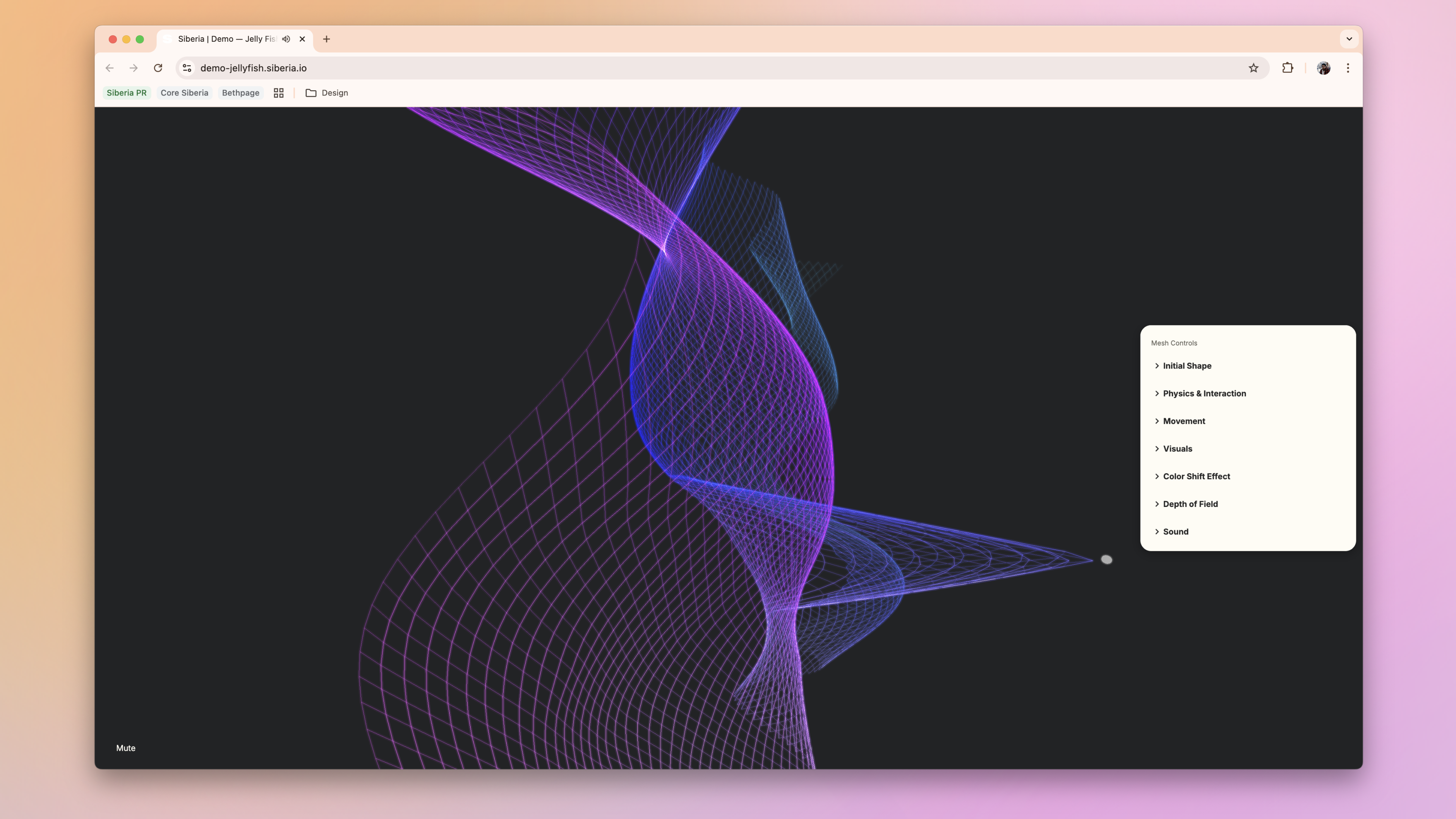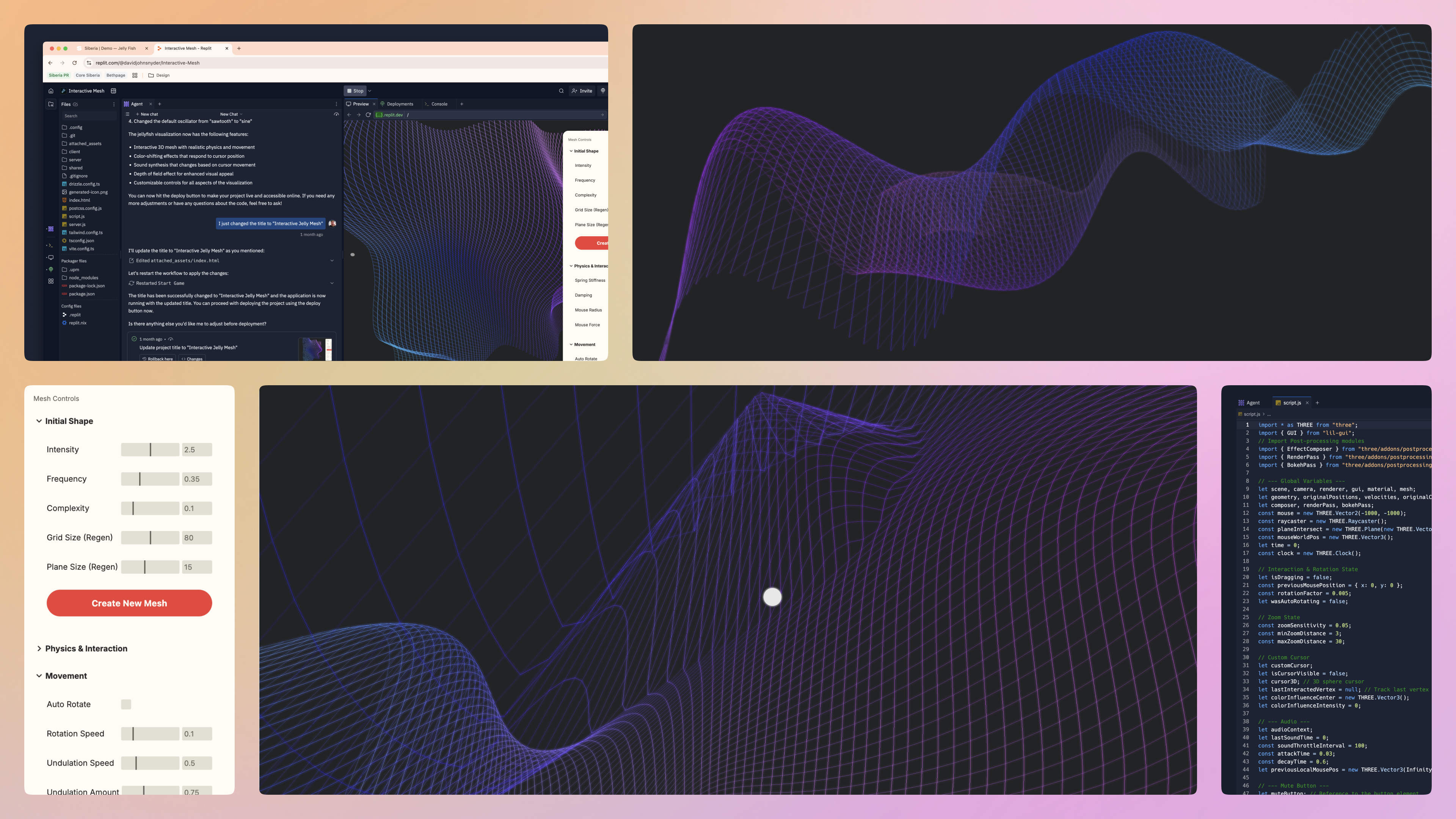
I recently built a thing. It’s weird, immersive, and its strange warbles are delightfully satisfying: a floating jelly mesh fabric that reacts to your mouse with a sense of a gravitational force, rotates in 3D space, and generates sounds as the cursor seemingly plucks the strings of the jelly mesh itself. You can zoom in, scroll around, mess with a control panel, and feel like you’re playing with some sort of squishy digital organism.
“Vibe coding.” There’s something to be said for approaching creativity with no brief, no business goal, and no constraints beyond: make something that feels interesting and slightly alive.
Here’s the link to my jelly mesh, if you want to play.
This wasn’t a client project. It wasn’t for a pitch deck. It was just for me.
This was a quick experiment – maybe five or six hours all in. The output was fun, but the process taught me more. Not just about AI pair programming, but about the shifting relationship between people, ideas, code – and why some folks in the creative space remain reluctant to dive in with AI.
Starting with AI: Gemini 2.5 + VSCode
I kicked things off using Google’s AI Studio + Gemini 2.5, running locally through VSCode. Gemini 2.5 was fast, lucid, and honestly pretty incredible when it came to creating the initial experience.
I gave it a vague prompt based on a 3D mesh object I created in Midjourney and said something like: “Make this object react to mouse movement in a 3-dimensional space. It should move like a jellyfish underwater.” It handled the heavy lifting – writing Three.js code, configuring shaders, even adding UI controls.
But here’s the rub: everything ran locally. And running complex WebGL experiences with AI support on your own machine quickly turns into a mess of permissions, dependencies, and edge-case bugs. It felt like half my time was spent asking the Gemini agent how to set up and install things like node.js via the terminal – which it did brilliantly.
Moving to Replit: Free vs. Core

Once I had the bones of the experience in place, I moved over to Replit to make deployment easier. I started on the Free tier, but that crashed and burned. The version of Claude on the basic model just, well, didn’t work. Not even close. Fair enough. I upgraded to the Core plan, pulled in what I had built locally, and suddenly everything clicked. The hosting was snappy. I could test on mobile. The agent is smart (but pricey). I could share a link. Magic.
That switch, from local to cloud-based dev, did more than save me time and a headache. It made the work easy to share. It reminded me that a lot of the friction we accept in software development may just be a thing of the past soon.
The real takeaway: AI made easy

Here’s the truth: the jelly mesh wasn’t hard to build.
I didn’t need a team. I didn’t spend a weekend. I didn’t even read any docs. I just asked the agent. AI gave me 99% of the code. I asked, tweaked, regenerated, and kept going. And because I had full control – from the shader logic to the cursor styling—I could dial in the details to make it feel pretty damn good – definitely worth sharing. And I have no doubt I could push this way further visually.
That’s the real shift. We’re past the point where AI helps with productivity. It’s now about access. It removes the barriers to weirdness, experimentation, and creative ownership. The sort of project that might’ve taken a junior dev two weeks a few years ago now takes a few hours and a curious brain.
And yet…
Why more people aren’t doing this
This little side project led me to a bigger, slightly uncomfortable thought:
A lot of people won’t explore what AI is capable of because they’re afraid of what it might reveal about their reality.
That applies to individuals and businesses.
Maybe your job depends on code complexity. Maybe your value comes from knowing arcane systems. Maybe your workflow is bloated, political, and slow – but it’s what pays the bills.
When you use AI to shortcut the whole thing, you’re not just being “innovative.” You’re opening the door to an existential audit.
It’s the same reason so many men avoid the doctor. Deep down, they don’t want to know.
This isn’t about fear mongering. I’m not saying every dev shop should panic, or that designers need to learn GLSL (they don’t). But the nature of craft is changing fast. If you define your value by your ability to navigate technical friction, AI is coming for you. But if your value lies in your ability to explore, create, and refine – with curiosity—then AI becomes a superpower.
That’s what this project reminded me of. I didn’t need permission. I didn’t need a client. I just needed an idea and a couple tools. That’s the frontier now. Fewer gatekeepers. Fewer excuses. Just time and vibes.
A final note to the skeptics
If you’ve been dragging your feet on AI tools – because they feel gimmicky, unstable, or soulless – I get it. But there’s something powerful in picking a weird little idea and just building it. Not to prove anything. Not to sell anything. Just you, getting out of your own way, to see what’s possible when tools and a new skill set stop being the barrier.
This jelly mesh won’t win any awards. It doesn’t need to. It was a quick reminder that when you remove the friction, curiosity does the rest.
And maybe that’s the whole point.
Want to take your workflow further? You'll need a decent laptop for game development.







